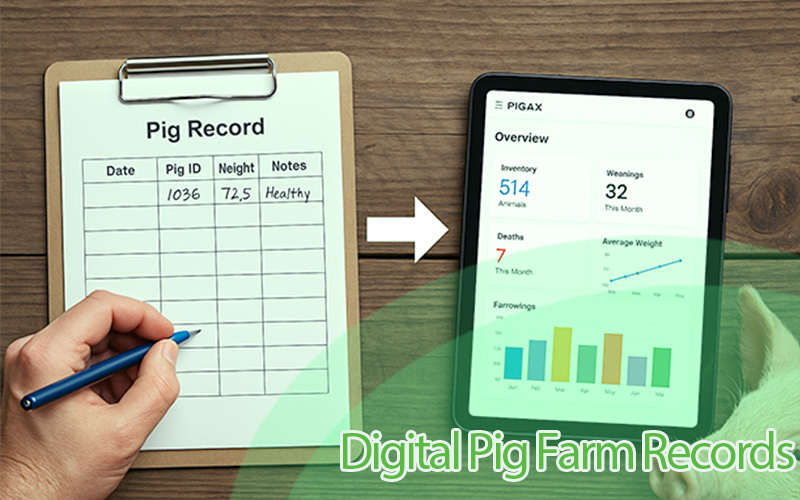How to Create and Maintain a Pig Profile
It may sound out of place to keep records of individual pigs in a pig farm since there are already several records of the overall performance of the farm. Why do we need to capture the essential details about each pig? Well, there are more benefits to maintaining an individual pig record. In this blog, we will explore some of these benefits, and the steps to create and manage an individual pig record system, starting with understanding the components of these records, identifying the major data to include, and discussing the importance of maintaining them.
What is Pig Profile
A pig profile is a comprehensive document that captures vital information about each pig on your farm. These records include a range of data points that provide insights into the health, growth, and overall status of each pig on your farm.
An individual pig record typically includes:
- Identification Details
- Birth Date and Origin
- Production cost
- Weight Records
- Nutrition logs
- Health status
- Breeding details
Major Data in a Pig profile
To effectively manage your pigs, you need to gather and record several key pieces of information. Each data point serves a specific purpose and contributes to a comprehensive understanding of your herd's status.
Identification Details: Assign a unique identifier to each pig, such as an ear tag number or a name. This ensures that you can distinguish each pig from the others, which is essential for accurate record-keeping.
Birth Date and Origin: Record the birth date of each pig and note where it was born. This information is vital for age-specific care and for tracking the pig's lineage.
Production Cost: All expenses incurred throughout the lifetime of the pig will be captured here. This also includes information relating to feeding, health, and all other miscellaneous expenses.
Weight Records: Regularly weigh your pigs and document their weights at different stages of growth. This helps in monitoring their development and identifying any potential health issues.
Health History: Keep detailed records of all health-related events, including vaccinations, illnesses, treatments, and veterinary visits. This history allows you to manage health problems effectively and prevent disease outbreaks.
Breeding Details: Document the pig's parents, breeding dates, and any offspring. This data is crucial for managing your breeding programs and improving genetic quality.
Feed and Nutrition Logs: Track what each pig is fed and any changes to their diet. Proper nutrition is fundamental to their growth and health, and these logs help you ensure that each pig is receiving the right nutrients.
By diligently recording this data, you create a valuable resource that enhances your ability to manage your pigs effectively, respond to health issues promptly, and optimize their growth and productivity.
Why Maintain Pig Profile
Maintaining individual pig records is not just a best practice; it's a necessity for the modern pig farm manager. The benefits of detailed record-keeping extend across various aspects of farm management, leading to healthier pigs, improved productivity, and greater economic returns.
Health Management and Disease Prevention
Detailed health records allow you to track each pig's medical history, ensuring timely vaccinations and treatments. This proactive approach helps prevent disease outbreaks and manage health issues before they escalate.
Improved Breeding Programs and Genetic Selection:
By recording breeding details and offspring information, you can make informed decisions about genetic selection. This leads to stronger, healthier pigs and improves the overall quality of your herd.
Enhanced Productivity and Performance Tracking:
Regular weight measurements and growth milestones enable you to monitor each pig's development closely. This data helps you identify and address any growth issues early, optimizing productivity.
Regulatory Compliance and Traceability:
Keeping comprehensive records ensures that you comply with industry regulations and standards. Traceability is crucial in the event of a health or safety issue, allowing you to track the origin and history of each pig quickly.
Economic Benefits and Cost Savings:
Efficient record-keeping leads to better decision-making, reducing costs associated with disease outbreaks, poor nutrition, and suboptimal breeding. Healthy, well-managed pigs grow faster and more efficiently, increasing your farm's profitability.
By investing time and effort into maintaining individual pig records, you create a foundation for a successful and sustainable pig farming operation. The insights gained from these records empower you to make informed decisions, improve herd health, and maximize productivity, ultimately contributing to the success of your farm.
Setting Up a Pig Profile
Creating an effective individual pig record system involves several crucial steps. By establishing a comprehensive and user-friendly system, you can ensure accurate and efficient record-keeping for your farm.
Choosing Between Digital and Manual Systems:
First, decide whether you prefer a digital or manual record-keeping system. Digital systems, such as specialized software or mobile apps, offer advantages like easy data retrieval, automated calculations, and backup options. Manual systems, using paper records, may be simpler to implement but require more effort to maintain and are prone to errors.
Selecting the Right Tools or Software:
If you choose a digital system, research and select software that meets your needs. Look for features like user-friendly interfaces, customizable templates, and compatibility with other farm management tools. Some popular options include PigCHAMP, Farmbrite, and Agrivi.
Creating Standardized Record Templates:
Develop standardized templates for recording data. Whether digital or manual, consistency is key to maintaining accurate records. Your templates should include fields for identification details, birth dates, weight records, health history, breeding details, feed logs, and growth milestones.
Establishing a Routine for Record Updates:
Create a schedule for updating records. This may include daily, weekly, or monthly updates, depending on the type of data. Implement regular routines for weighing pigs, conducting health assessments, and recording growth milestones. Use calibrated scales and ensure that data entry is done promptly and accurately. Assign specific responsibilities to your staff to ensure that updates are timely and consistent.
Common Challenges in Maintaining Pig Profile
Despite the benefits, maintaining a pig profile can present challenges. Here’s how you can address some common obstacles:
Data Entry Errors:
Errors in data entry can compromise the accuracy of your records. Implement double-check procedures and cross-reference data with other records to ensure accuracy. Training your staff on proper data entry techniques also minimizes errors.
System Integration Issues:
Integrating record-keeping systems with other farm management tools can be complex. Choose software that is compatible with your existing systems and seek technical support if needed. Regularly update your systems to ensure smooth integration.
Lack of staff training
Ensuring that all farm staff are proficient in record-keeping is essential. Provide comprehensive training on the importance of accurate records and the specific procedures for data collection and entry. Regularly update training to incorporate new practices and technologies.
Inconsistency in data entry:
Consistency in data collection and entry is crucial. Establish clear protocols and schedules for updating records. Assign specific responsibilities to staff members and monitor adherence to these protocols to maintain consistency.
Conclusion
Maintaining individual pig records is a cornerstone of effective pig farming. These records provide invaluable insights into your herd's health, growth, and productivity, enabling you to make informed decisions and optimize your farm operations. By understanding the components of individual pig records, gathering the necessary data, and leveraging these records for farm management, you can enhance the overall success of your farming operation.
Investing time and effort into setting up and maintaining an individual pig record system is a wise decision that pays off in numerous ways. From improved health management and disease prevention to better breeding programs and economic benefits, detailed records are essential for modern pig farming.




